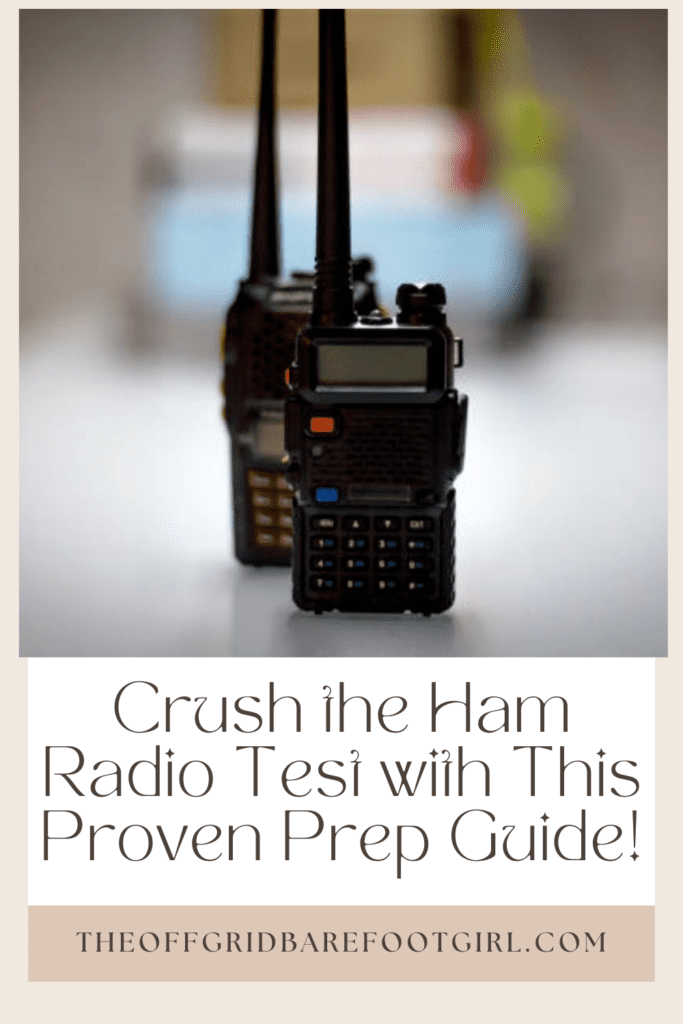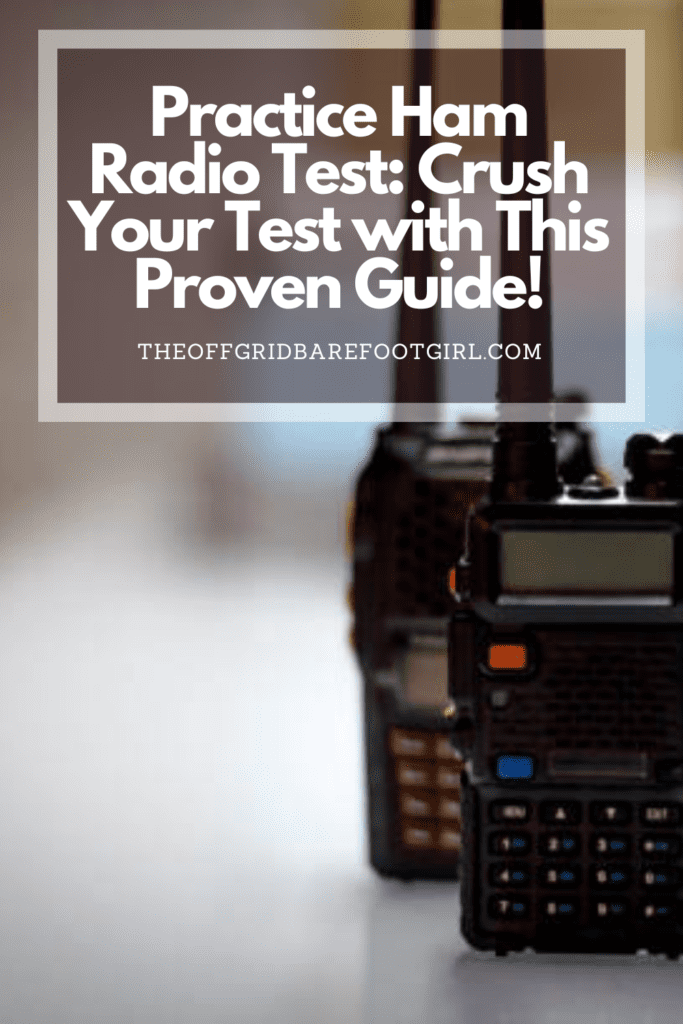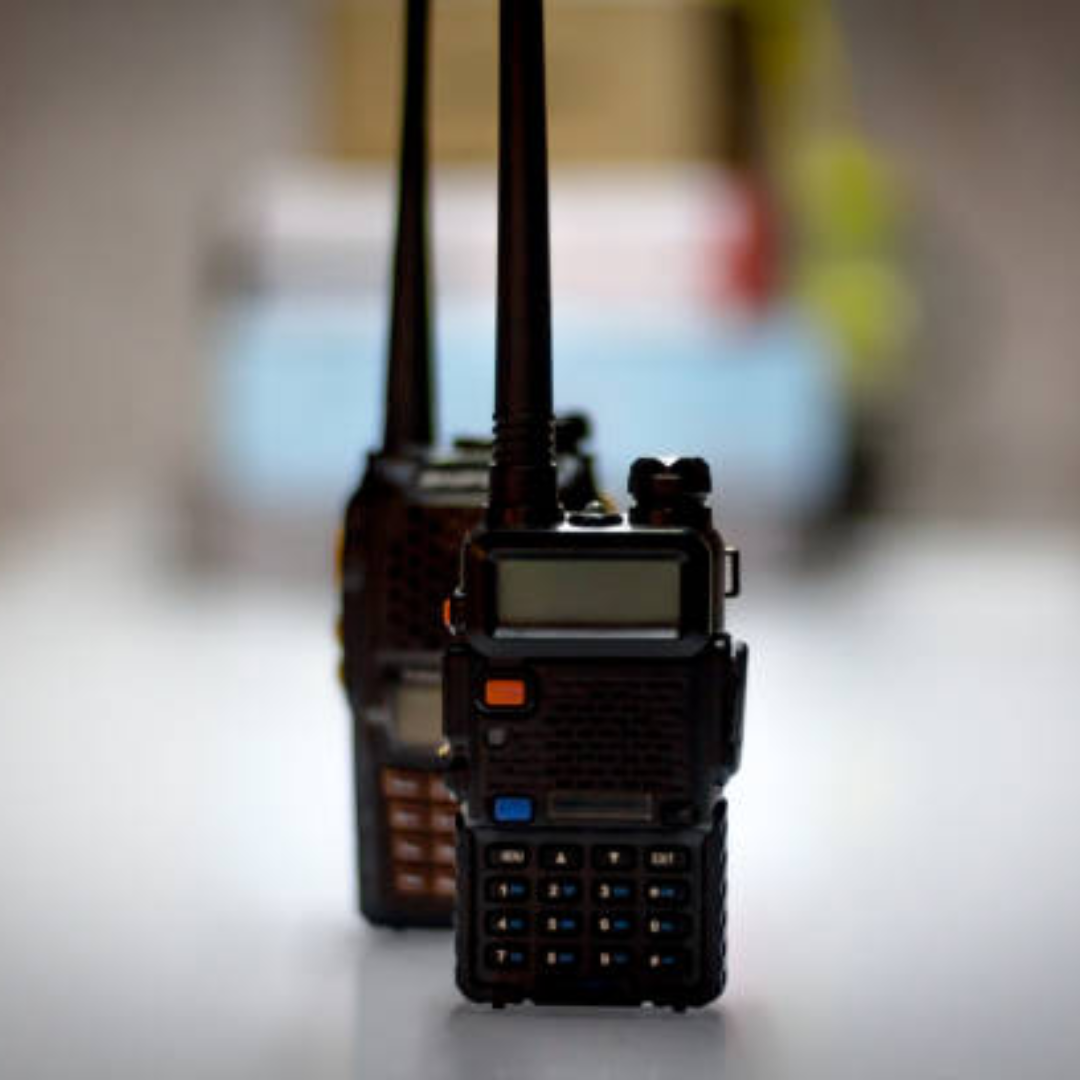Passing the ham radio test doesn’t have to be overwhelming. This proven prep guide breaks down what you need to study, how to practice effectively, and how to feel confident on exam day—so you can earn your license and be ready when communication matters most.
When I first started looking into ham radio, I’ll be honest—it felt intimidating. The terminology, the rules, the test… it all sounded way more complicated than I expected. But once I broke it down and focused on what actually mattered, it became not only doable, but empowering. Reliable communication is a huge part of being prepared, especially when the grid goes down. In this guide, I’m sharing the exact prep approach that helped make the ham radio test feel manageable, so you can pass with confidence and add a skill that truly matters!
This is a pinnable post. Tap or hover over any image in this post to pin to your Pinterest Boards.

Purpose of the Ham Radio Test
The purpose of the Ham Radio Test is to assess the knowledge and skills of individuals seeking to obtain an amateur radio license. This test ensures that operators have a basic understanding of radio theory, regulations, and operating procedures to communicate effectively over radio frequencies.
Test Structure and Format
The Ham Radio Test typically consists of multiple-choice questions that cover various aspects of amateur radio operations. The test may include questions on technical knowledge, operating procedures, regulations, and practical applications. Understanding the structure and format of the test is essential for effective preparation and performance on exam day.
Topics Covered in the Test
The topics covered in the Ham Radio Test are diverse and encompass a range of subjects related to amateur radio operations. From electromagnetic principles to emergency communication protocols, test-takers need to have a comprehensive understanding of various areas to succeed in the exam. Being familiar with the topics covered will help aspirants focus their preparation on key areas to maximize their chances of success.
Licensing Requirements
Before taking the Ham Radio Test, it is crucial to understand the licensing requirements set by the regulatory authority. Different license levels may have specific requirements in terms of technical knowledge and operating privileges. Knowing the licensing requirements will guide you on which exam to prepare for and what privileges you can expect upon passing the test.
Understanding the Ham Radio Test
Purpose of the Ham Radio Test
The primary purpose of the Ham Radio Test, also known as the Amateur Radio License Exam, is to ensure that you possess the necessary knowledge and skills to operate an amateur radio station safely and effectively. By passing the exam, you demonstrate your understanding of essential concepts related to radio operation, regulations, and safety practices.
Test Structure and Format
The Ham Radio Test typically consists of multiple-choice questions to assess your knowledge across different areas of amateur radio operation. The exam is divided into three levels – Technician, General, and Extra – each requiring a progressively deeper understanding of radio principles. You must choose the correct answer from the options provided, testing both theoretical knowledge and practical applications.
Topics Covered in the Test
The exam covers a range of topics essential for operating an amateur radio station proficiently. These include radio wave propagation, frequency regulations, station setup, operating procedures, basic electronic principles, and safety protocols. Understanding these concepts is crucial for effective communication and compliance with regulations set by the Federal Communications Commission (FCC).
Licensing Requirements
To operate an amateur radio station legally in the United States, you must obtain an amateur radio license issued by the FCC. The license class (Technician, General, Extra) determines the privileges and frequencies that a licensee can access. Licensing requirements vary based on the class of license sought, with each class opening up additional opportunities for experimentation and communication within the amateur radio community.
Get 10% Off Any Course or Bundle for Your Ham Radio Test Prep!
Enhance your ham radio test preparation by signing up for these comprehensive prep courses, designed to equip you with all the knowledge and skills you need to ace the exam!
These courses offer in-depth tutorials, interactive lessons, and practice tests that mirror the actual exam format. Plus, you can enjoy a 10% discount on all courses and bundles by using my code BarefootGirl at checkout. Don’t miss this opportunity to invest in your success and join the ranks of licensed ham radio operators with confidence and ease.
Sign up today and take the first step toward mastering the ham radio test!

Preparing for the Ham Radio Test
Study Materials and Resources
When preparing for the Ham Radio test, having the right study materials is crucial. Consider the following resources:
- ARRL License Manuals: These are comprehensive guides covering all aspects of the test.
- Online Forums and Communities: Platforms like QRZ and eHam offer valuable insights and support.
- Mobile Apps: Apps like Ham Test Prep provide convenient study tools on the go.
Practice Exams and Simulations
Practice exams and simulations are essential to gauge your readiness for the test. Here’s how to approach them effectively:
- Online Practice Tests: Websites like Ham Test Prep offer practice exams similar to the actual test.
- Simulated Exams: Use software like Ham Test Prep to simulate exam conditions for better preparation.
- Review and Analyze: After each practice test, review incorrect answers to understand your weak areas.
Effective Study Techniques
To optimize your study sessions, consider the following effective techniques:
- Pomodoro Technique: Use 25-minute study intervals followed by short breaks for improved focus.
- Flashcards: Create flashcards for key concepts to aid in memory retention.
- Teach Someone: Explaining concepts to someone else can reinforce your understanding.
Seeking Guidance from Experts
Seeking guidance from experienced ham radio operators can provide valuable insights and tips:
- Local Clubs and Elmers: Joining local clubs or reaching out to Elmers can offer mentorship and practical advice.
- Online Communities: Platforms like Reddit’s r/amateurradio can connect you with a vast community for guidance.
- Attend Workshops and Seminars: Participating in workshops and seminars can enhance your knowledge base.
Core Concepts and Skills
Electromagnetic Principles
Understanding electromagnetic principles is fundamental to operating a ham radio effectively. Here are some key points to focus on:
- Wave Theory: Learn about wavelength, frequency, and propagation of electromagnetic waves.
- Antenna Basics: Understand how antennas interact with electromagnetic waves for transmission and reception.
- Propagation Paths: Explore how radio waves travel over various paths such as ground wave, sky wave, and line of sight.
- Interference Management: Know how to identify and mitigate interference issues using electromagnetic principles.
Operating Procedures
Mastering operating procedures ensures efficient and effective communication while adhering to regulations. Consider the following:
- Call Signs: Learn the significance of call signs and proper usage during transmissions.
- Q Codes and Procedures: Familiarize yourself with common Q codes and communication protocols for clarity.
- Emergency Protocols: Understand emergency communication procedures and how to assist in distress situations.
- Net Operations: Gain knowledge about participating in nets and following net control procedures.
Antennas and Propagation
Antennas and propagation play a critical role in the performance of a ham radio station. Key points to study include:
- Antenna Types: Explore various antenna designs like dipole, Yagi, and vertical antennas.
- Antenna Tuning: Understand the importance of tuning antennas for optimal performance.
- Propagation Effects: Learn how factors like weather and solar conditions affect signal propagation.
- Antenna Installation: Know the best practices for installing and grounding antennas for safety and performance.
Understanding Ham Radio Aerials
For a comprehensive understanding of the crucial role ham radio aerials play in survival communication, be sure to read my detailed post on “Why You Need Ham Radio Aerials for Your Survival Communication!” This post discusses the many advantages of using ham radio aerials, including their ability to maintain communication when conventional networks fail, their long-range capabilities, and their adaptability in various emergency scenarios.
You’ll find in-depth explanations and practical advice that highlight the importance of these aerials in ensuring reliable and effective communication during critical times. Don’t miss out on this valuable information that could make all the difference in your preparedness and safety!
Why You Need Ham Radio Aerials for Your Survival Communication!
Regulations and Ethics
Comprehending the regulations and ethics governing ham radio is essential for responsible operation. Focus on the following aspects:
- FCC Rules: Study the regulations set forth by the FCC regarding ham radio operation.
- Band Usage: Understand the band allocations and restrictions for different license classes.
- Interference Mitigation: Learn how to avoid causing interference to other radio services.
- Ethical Conduct: Emphasize the importance of ethical behavior, courtesy, and respect towards other operators.

Technical Knowledge
Frequency Allocations and Band Planning
Understanding frequency allocations and band planning is crucial for efficiently utilizing the radio spectrum in amateur radio operations. Here are key points to consider:
- Frequency Allocations: Learn about the specific frequency ranges allocated for different license classes and types of communication.
- Band Planning: Familiarize yourself with the organization of frequency bands within each amateur radio band to avoid interference and make optimal use of the available spectrum.
- International Regulations: Understand the international regulations governing frequency allocations to ensure compliance and harmonious coexistence with other radio services.
Modulation Techniques
Mastering modulation techniques is essential for effective radio communication. Here’s what you need to know:
- Types of Modulation: Explore various modulation techniques such as Amplitude Modulation (AM), Frequency Modulation (FM), and Digital Modulation like Phase Shift Keying (PSK).
- Modulation Schemes: Understand the principles behind modulation schemes used in amateur radio to transmit voice, data, and other signals efficiently.
- Modulation Performance: Learn how different modulation techniques impact signal strength, bandwidth efficiency, and resilience to noise for optimized communication.
Equipment Operation and Maintenance
Operating and maintaining radio equipment properly is vital for reliable communication. Consider the following:
- Equipment Familiarization: Get acquainted with different types of amateur radio equipment, including transceivers, antennas, and accessories.
- Operating Procedures: Practice safe and correct operation of equipment to prevent damage and ensure efficient transmission.
- Maintenance Practices: Learn basic maintenance tasks like antenna checks, firmware updates, and regular inspections to keep equipment in top condition for consistent performance.
Safety Procedures
Prioritizing safety while operating radio equipment is paramount. Here are essential safety practices to follow:
- RF Exposure: Understand the risks associated with Radio Frequency (RF) exposure and adhere to safety guidelines to limit exposure levels.
- Electrical Safety: Implement proper grounding, use of surge protectors, and insulation to prevent electric shocks and equipment damage.
- Emergency Protocols: Familiarize yourself with emergency procedures in case of equipment malfunction, electrical hazards, or other safety threats to respond promptly and effectively.
Practical Applications
Emergency Communication Protocols
In ham radio, operators play a crucial role in emergency communication during disasters when regular communication channels may be disrupted. Understanding emergency protocols is vital for efficiently relaying information and coordinating response efforts. Here are some key points related to emergency communication protocols in ham radio:
- Traffic Handling: Learning how to efficiently handle message traffic, including formal messages and emergency priority traffic.
- Net Operations: Participating in emergency nets and understanding net procedures for effective communication.
- Resource Coordination: Coordinating resources and information flow among ham radio operators and emergency services.
Contesting and DX Operations
Engaging in contests and long-distance (DX) communication activities not only adds excitement but also enhances skills in operating under varying conditions. Contesting and DX operations offer opportunities to improve signal propagation knowledge and antenna efficiency. Here are some aspects related to contesting and DX operations in ham radio:
- Competition Skills: Developing skills in rapid and accurate communication to compete effectively in contests.
- Propagation Study: Understanding how radio waves travel over long distances to optimize DX communication.
- Antenna Optimization: Experimenting with different antenna configurations to improve signal strength for distant contacts.
Digital Modes and Data Transmission
With advancements in technology, ham radio now includes digital modes for data transmission, offering efficient and reliable ways to communicate. Mastering digital modes opens up avenues for various applications such as weather reporting, text messaging, and image transmission. Here are some key points related to digital modes and data transmission in ham radio:
- Software Proficiency: Using software like WSJT-X for modes like FT8 and JT65 for weak signal communication.
- Error Correction: Understanding error correction techniques used in digital modes to ensure accurate data transmission.
- Interface Setup: Configuring sound card interfaces and digital mode software for seamless transmission and reception.
Satellite and Space Communications
For ham radio enthusiasts looking to explore beyond terrestrial communication, satellite and space communications provide a fascinating avenue. Operating through satellites orbiting the Earth offers unique challenges and rewards, requiring specialized equipment and tracking techniques. Here are some aspects related to satellite and space communications in ham radio:
- Satellite Tracking: Utilizing tools like tracking software and antenna rotators to follow satellite passes accurately.
- Doppler Effect: Understanding and compensating for Doppler shifts in satellite communication frequencies.
- Equipment Setup: Configuring handheld transceivers or dedicated satellite stations for uplink and downlink communication.

Exam Strategies and Techniques
Time Management
Effective time management is crucial during the Ham Radio Test to ensure you can address all questions within the allocated time. Here are some useful tips:
- Prioritize: Start with questions you are confident about to build momentum.
- Keep Track: Monitor the time to allocate sufficient minutes per question.
- Skip and Return: If stuck on a question, move on and come back later to avoid getting stuck.
Question Analysis and Answer Approaches
Understanding how to analyze and approach questions is essential for exam success. Consider the following strategies:
- Read Carefully: Pay close attention to keywords like “not” or “except,” which can change the meaning.
- Process of Elimination: Eliminate obviously wrong answers to improve the chances of selecting the correct one.
- Use Context Clues: Sometimes, information in one question can help with another.
Elimination Strategies
Utilizing elimination strategies can significantly enhance your odds of selecting the correct answer:
- Focus on Extreme Terms: Extreme terms like “always” or “never” are often incorrect.
- Look for Redundancy: Answers that repeat information from the question are likely correct.
- Consider Outliers: Answers that do not fit the pattern of the other options are usually incorrect.
Test-Day Preparation
Proper preparation on the day of the exam can help alleviate stress and boost performance. Consider these tips:
- Rest Well: Ensure you get a good night’s sleep before the test.
- Arrive Early: Reach the test center with ample time to account for any unexpected delays.
- Stay Calm: Practice relaxation techniques to manage anxiety during the exam.
Post-Test Considerations
License Application Process
After successfully passing the Ham Radio Test, the next step is to apply for your license. Here are the key points to consider during the application process:
- Contact the appropriate authority: Depending on your location, you will need to contact the relevant regulatory body to apply for your ham radio license.
- Submit necessary documentation: Prepare and submit all required documents, including your test results and identification.
- Pay applicable fees: There might be fees associated with the license application, so ensure you have the necessary funds ready.
- Await approval: Once your application is submitted, you will need to wait for approval before you can start operating as a licensed ham radio operator.
Joining the Ham Radio Community
Becoming part of the ham radio community can enhance your overall experience and provide valuable support. Here’s how you can get involved:
- Join a local ham radio club: Connecting with fellow enthusiasts can offer networking opportunities, knowledge sharing, and practical experiences.
- Attend events and meetings: Participating in club meetings, field days, and other events can help you learn from experienced operators and expand your skills.
- Engage in online forums: Virtual communities provide a platform to ask questions, seek advice, and stay updated on the latest trends in the ham radio world.
- Volunteer for community service events: Using your radio skills for public service activities not only benefits others but also enhances your proficiency as an operator.
Continuing Education and Advancement
To stay current and advance in the world of ham radio, consider the following:
- Pursue advanced licenses: As you gain experience, you can aim for higher-level licenses, allowing you access to more frequencies and operating privileges.
- Attend specialized workshops and courses: Enhance your knowledge by attending workshops on specific topics like antenna design, propagation, or emergency communications.
- Participate in contests and exercises: Engaging in on-air contests and emergency drills can sharpen your operating skills and introduce you to new aspects of the hobby.
- Stay updated on regulations: Regulations in the radio space can change, so staying informed will ensure you operate within legal boundaries.
Equipment Selection and Setup
Choosing the right equipment and setting it up correctly is crucial for a seamless ham radio experience. Consider the following when selecting and configuring your gear:
- Research and invest in quality equipment: Quality gear can enhance the clarity and reliability of your transmissions.
- Set up your station effectively: Properly install antennas, ground your equipment, and follow best practices for minimizing interference.
- Learn about maintenance: Regular maintenance of your equipment is essential for longevity and optimal performance.
- Experiment with different setups: Trying out various configurations can help you understand what works best for your specific operating needs.

Things to Consider
Reflecting on Your Achievement
Take a moment to reflect on the hard work and dedication you put into preparing for the Ham Radio Test. Whether you aced the exam or faced challenges, remember that the journey itself is a valuable learning experience.
Embracing the Ham Radio Community
Now that you have passed the test and obtained your license, it’s time to embrace the vibrant Ham Radio community. Connect with fellow enthusiasts, participate in events, and engage in conversations to deepen your knowledge and enthusiasm for amateur radio.
Committing to Lifelong Learning
Obtaining your Ham Radio license is just the beginning of your journey. Commit to lifelong learning by staying updated on advancements in radio technology, regulations, and operating practices. Consider pursuing higher license classes to expand your privileges and knowledge further.
Sharing Your Passion
As a licensed Ham Radio operator, you have the opportunity to share your passion for radio communication with others. Introduce friends and family to the world of amateur radio, mentor aspiring operators, and participate in activities that promote the growth of the hobby.
Exploring New Horizons
Amateur radio offers a vast array of activities and specialties to explore. From contesting to satellite communications, there is always something new to learn and experience. Keep an open mind, step out of your comfort zone, and embrace the diverse opportunities that amateur radio has to offer.
Continuing Your Ham Radio Journey
Your journey in the world of amateur radio is a continuous adventure filled with learning, challenges, and exciting experiences. Stay curious, be proactive in your involvement, and let your passion for radio communication drive you toward new achievements and connections within the community.
Conclusion
In conclusion, mastering the ham radio test is within your reach with the right preparation and resources. By following the strategies outlined in this guide, you’ll gain a solid understanding of the material, build confidence through practice, and develop the skills necessary to excel. Remember, consistent study, utilizing practice tests, and familiarizing yourself with key concepts are all essential steps to success. With dedication and the proven tips from this guide, you’ll be well-equipped to crush your ham radio test and start on an exciting journey as a licensed ham radio operator. Happy studying, and good luck!
For more details on thriving in your life, read my post The Complete Guide to Emergency Preparedness: Everything You Need to Thrive in Any Situation
Resources: Here are some helpful resources for further information.
- Free Ham Radio License Practice Tests – By Ham Radio Prep
- How Many Questions on the Ham Radio Test? – By Ham Radio Prep
- Ham Radio Online License Classes – By Ham Radio Prep

Frequently Asked Questions
1. What is the most effective way to prepare for the ham radio test?
The most effective way to prepare for the ham radio test is by combining a thorough study of the exam material with regular practice tests. Focus on understanding key concepts, regulations, and operating procedures. Utilize resources like study guides, online courses, and flashcards to reinforce your knowledge. Regularly taking practice tests will help you familiarize yourself with the exam format and identify areas where you need more review.
2. How can practice tests help me pass the ham radio exam?
Practice tests are invaluable tools for passing the ham radio exam. They help you gauge your understanding of the material, identify weak areas, and improve your test-taking skills. By simulating the actual exam experience, practice tests reduce anxiety and build confidence. They also allow you to become accustomed to the types of questions you will encounter, improving your ability to recall information quickly and accurately during the actual test.
3. What resources are recommended for studying for the ham radio test?
Recommended resources for studying include the ARRL Ham Radio License Manual, online courses like those offered by HamStudy and Ham Radio Prep, and mobile apps for on-the-go learning. Additionally, joining a local ham radio club can provide valuable support and mentorship. Many clubs offer study sessions and access to experienced operators who can answer questions and provide practical insights.
4. How much time should I dedicate to studying for the ham radio test?
The amount of time needed to study for the ham radio test varies depending on your background knowledge and learning pace. Generally, dedicating an hour a day for several weeks is sufficient for most people. It’s important to pace yourself and focus on consistent, regular study sessions rather than cramming. Regular review and practice, especially with practice tests, will ensure you retain the information and feel well-prepared on exam day.
Summary
I hope I have inspired you to obtain your ham radio license with these helpful tips and products. Here are some other links you may be interested in reading!
Why You Need Ham Radio Aerials for Your Survival Communication!
How to Shop the Amish Market: Scoring Big Savings!
Survive the Peaks: The Best Avalanche Gear on the Market!
Bug In and Survive a Grid Down: Survival Training Course!
Bugout Bags and Survival Training Course with Grid Down Consulting!
Get These Vital Emergency Survival Equipment Now!
Bartering: How To Negotiate Commodities with Astonishing Results!
Warning: Why You Need Whole Home Water Purification Now!
How to Design Off Grid Power Systems for Your Homestead
How Many Watts Does a Fridge Use? Energy Efficient Guide
The Best States for Off Grid Living: Unplugged and Thriving
Composting Toilet Systems Are Surging: Ditch Your Septic Tank Now!
Are Greywater Tanks the Key to Sustainable Living? Find Out Now!
How to Live Off-Grid: 11 Tips to Survive and Thrive!
Are Survival Food Kits Worth It? The Truth Revealed!
Do You Really Need Faraday Bags? The Shocking Truth Revealed!
The Best Doomsday Preppers Blogs to Follow Now Before SHTF!
The Ultimate Camping Gear Checklist: Everything You Need for an Adventure
The Ultimate Spring Cleaning House Checklist: Deep Clean with Me!
How Supporting Farmer’s Markets Makes a Difference
Eco-Friendly Christmas: How to Have an Eco-Friendly Christmas
How to Winterize Your Home: Prepare for Jack Frost’s Wrath!
Proven Hacks to Make Your Christmas Tree Survive
What Thanksgiving Teaches Us About Survival
Homeless Survival Hacks to Overcome Adversity
More Self-Sufficiency Posts!
Is Your Car Ready for Winter? The Ultimate Checklist for Your Winter Emergency Car Kit
What The Walking Dead Can Teach Us About Survival: The Walking Dead Survival Tactics
Get Lockdown Ready: Best Dollar Tree Survival Items
Understanding Water Purification Methods for Survival: Best Practices Explained
Thirsty for Survival: Expert Guide to Emergency Water Prep Tactics
The Benefits of Urban Homesteading: Revolutionize Your City Life
Practical Pantry Prepper: Essential Guide
How to Grocery Shop Once a Month
What Should Be in A 72-Hour Survival Kit?
Buy or Die: Prepper Items You Need Now
How to Learn 58 Self-Sufficient Skills Right Now
Road to Self-Sufficiency: How to Start Your Journey
If you were encouraged by this post, I invite you to check out my FREE Printables Page for fun free printables, planners, and charts.
ENTER MY FREE Printables Page HERE
Blessings,
The Off Grid Barefoot Girl






